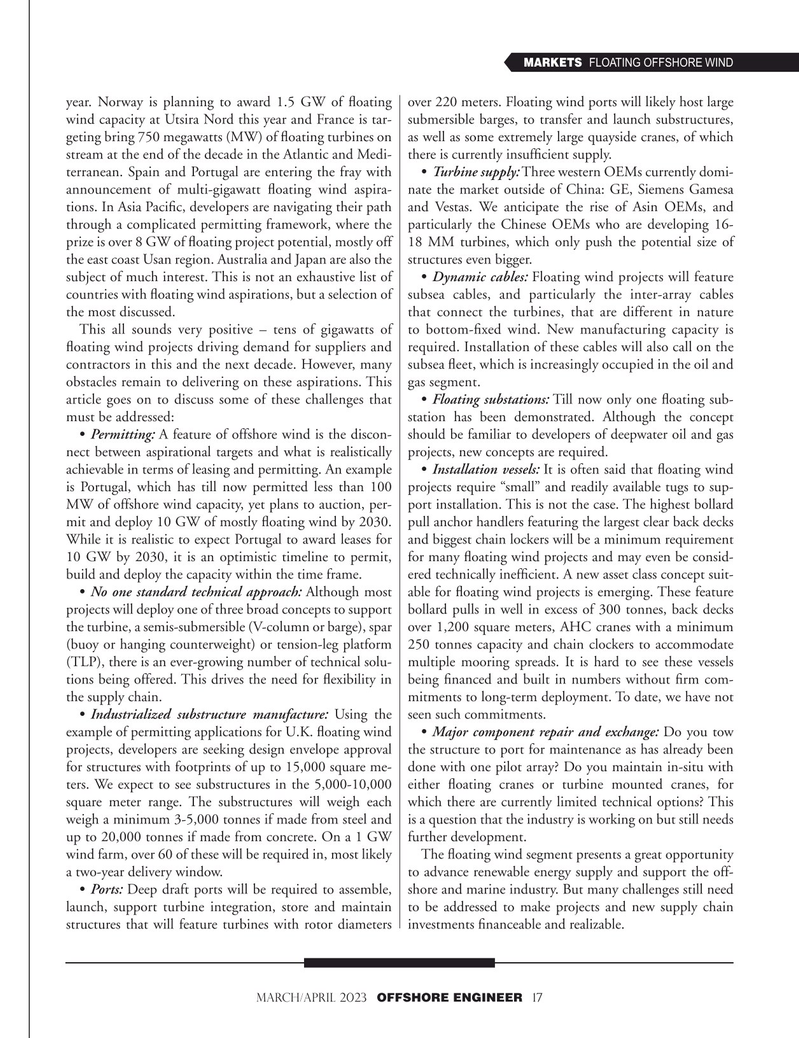
Page 17: of Offshore Engineer Magazine (Mar/Apr 2023)
Read this page in Pdf, Flash or Html5 edition of Mar/Apr 2023 Offshore Engineer Magazine
MARKETS FLOATING OFFSHORE WIND year. Norway is planning to award 1.5 GW of foating over 220 meters. Floating wind ports will likely host large wind capacity at Utsira Nord this year and France is tar- submersible barges, to transfer and launch substructures, geting bring 750 megawatts (MW) of foating turbines on as well as some extremely large quayside cranes, of which stream at the end of the decade in the Atlantic and Medi- there is currently insuffcient supply. terranean. Spain and Portugal are entering the fray with • Turbine supply: Three western OEMs currently domi- announcement of multi-gigawatt foating wind aspira- nate the market outside of China: GE, Siemens Gamesa tions. In Asia Pacifc, developers are navigating their path and Vestas. We anticipate the rise of Asin OEMs, and through a complicated permitting framework, where the particularly the Chinese OEMs who are developing 16- prize is over 8 GW of foating project potential, mostly off 18 MM turbines, which only push the potential size of the east coast Usan region. Australia and Japan are also the structures even bigger. subject of much interest. This is not an exhaustive list of • Dynamic cables: Floating wind projects will feature countries with foating wind aspirations, but a selection of subsea cables, and particularly the inter-array cables the most discussed. that connect the turbines, that are different in nature
This all sounds very positive – tens of gigawatts of to bottom-fxed wind. New manufacturing capacity is foating wind projects driving demand for suppliers and required. Installation of these cables will also call on the contractors in this and the next decade. However, many subsea feet, which is increasingly occupied in the oil and obstacles remain to delivering on these aspirations. This gas segment. article goes on to discuss some of these challenges that • Floating substations: Till now only one foating sub- must be addressed: station has been demonstrated. Although the concept • Permitting: A feature of offshore wind is the discon- should be familiar to developers of deepwater oil and gas nect between aspirational targets and what is realistically projects, new concepts are required.
achievable in terms of leasing and permitting. An example • Installation vessels: It is often said that foating wind is Portugal, which has till now permitted less than 100 projects require “small” and readily available tugs to sup-
MW of offshore wind capacity, yet plans to auction, per- port installation. This is not the case. The highest bollard mit and deploy 10 GW of mostly foating wind by 2030. pull anchor handlers featuring the largest clear back decks
While it is realistic to expect Portugal to award leases for and biggest chain lockers will be a minimum requirement 10 GW by 2030, it is an optimistic timeline to permit, for many foating wind projects and may even be consid- build and deploy the capacity within the time frame. ered technically ineffcient. A new asset class concept suit- • No one standard technical approach: Although most able for foating wind projects is emerging. These feature projects will deploy one of three broad concepts to support bollard pulls in well in excess of 300 tonnes, back decks the turbine, a semis-submersible (V-column or barge), spar over 1,200 square meters, AHC cranes with a minimum (buoy or hanging counterweight) or tension-leg platform 250 tonnes capacity and chain clockers to accommodate (TLP), there is an ever-growing number of technical solu- multiple mooring spreads. It is hard to see these vessels tions being offered. This drives the need for fexibility in being fnanced and built in numbers without frm com- the supply chain. mitments to long-term deployment. To date, we have not • Industrialized substructure manufacture: Using the seen such commitments.
example of permitting applications for U.K. foating wind • Major component repair and exchange: Do you tow projects, developers are seeking design envelope approval the structure to port for maintenance as has already been for structures with footprints of up to 15,000 square me- done with one pilot array? Do you maintain in-situ with ters. We expect to see substructures in the 5,000-10,000 either foating cranes or turbine mounted cranes, for square meter range. The substructures will weigh each which there are currently limited technical options? This weigh a minimum 3-5,000 tonnes if made from steel and is a question that the industry is working on but still needs up to 20,000 tonnes if made from concrete. On a 1 GW further development. wind farm, over 60 of these will be required in, most likely The foating wind segment presents a great opportunity a two-year delivery window. to advance renewable energy supply and support the off- • Ports: Deep draft ports will be required to assemble, shore and marine industry. But many challenges still need launch, support turbine integration, store and maintain to be addressed to make projects and new supply chain structures that will feature turbines with rotor diameters investments fnanceable and realizable.
MARCH/APRIL 2023 OFFSHORE ENGINEER 17

 16
16

 18
18